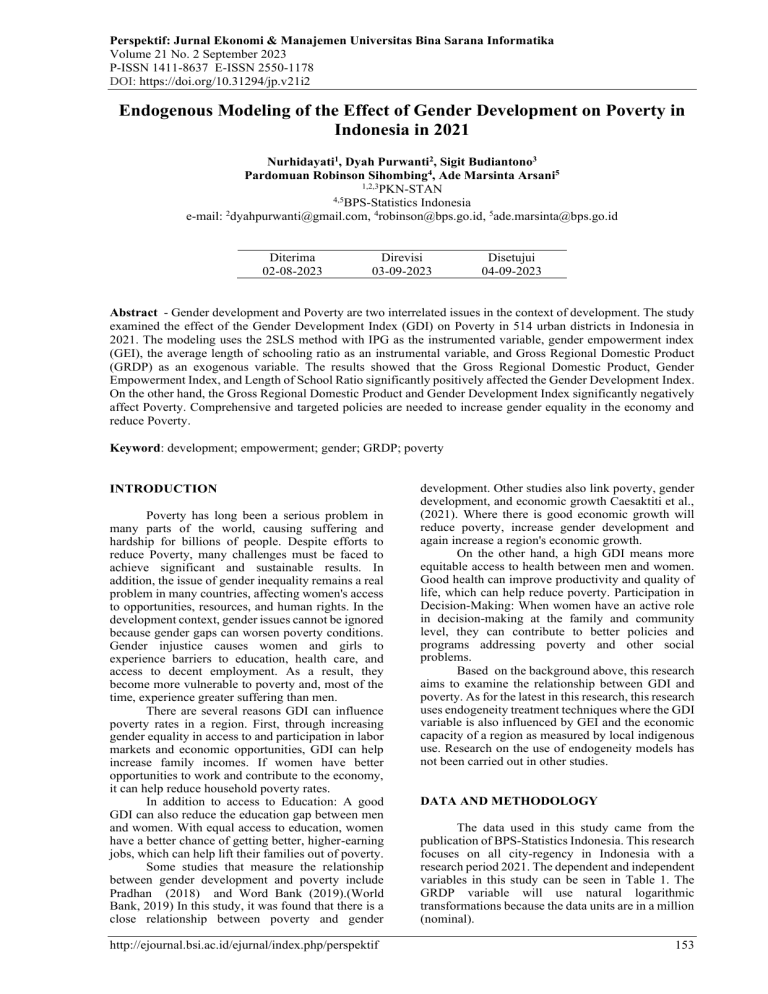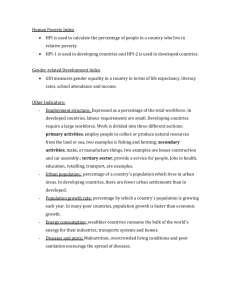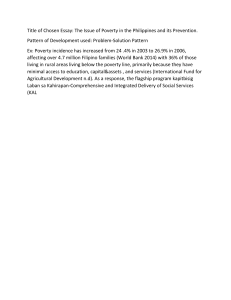
Perspektif: Jurnal Ekonomi & Manajemen Universitas Bina Sarana Informatika Volume 21 No. 2 September 2023 P-ISSN 1411-8637 E-ISSN 2550-1178 DOI: https://doi.org/10.31294/jp.v21i2 Endogenous Modeling of the Effect of Gender Development on Poverty in Indonesia in 2021 Nurhidayati1, Dyah Purwanti2, Sigit Budiantono3 Pardomuan Robinson Sihombing4, Ade Marsinta Arsani5 1,2,3 PKN-STAN 4,5 BPS-Statistics Indonesia e-mail: 2dyahpurwanti@gmail.com, 4robinson@bps.go.id, 5ade.marsinta@bps.go.id Diterima 02-08-2023 Direvisi 03-09-2023 Disetujui 04-09-2023 Abstract - Gender development and Poverty are two interrelated issues in the context of development. The study examined the effect of the Gender Development Index (GDI) on Poverty in 514 urban districts in Indonesia in 2021. The modeling uses the 2SLS method with IPG as the instrumented variable, gender empowerment index (GEI), the average length of schooling ratio as an instrumental variable, and Gross Regional Domestic Product (GRDP) as an exogenous variable. The results showed that the Gross Regional Domestic Product, Gender Empowerment Index, and Length of School Ratio significantly positively affected the Gender Development Index. On the other hand, the Gross Regional Domestic Product and Gender Development Index significantly negatively affect Poverty. Comprehensive and targeted policies are needed to increase gender equality in the economy and reduce Poverty. Keyword: development; empowerment; gender; GRDP; poverty INTRODUCTION Poverty has long been a serious problem in many parts of the world, causing suffering and hardship for billions of people. Despite efforts to reduce Poverty, many challenges must be faced to achieve significant and sustainable results. In addition, the issue of gender inequality remains a real problem in many countries, affecting women's access to opportunities, resources, and human rights. In the development context, gender issues cannot be ignored because gender gaps can worsen poverty conditions. Gender injustice causes women and girls to experience barriers to education, health care, and access to decent employment. As a result, they become more vulnerable to poverty and, most of the time, experience greater suffering than men. There are several reasons GDI can influence poverty rates in a region. First, through increasing gender equality in access to and participation in labor markets and economic opportunities, GDI can help increase family incomes. If women have better opportunities to work and contribute to the economy, it can help reduce household poverty rates. In addition to access to Education: A good GDI can also reduce the education gap between men and women. With equal access to education, women have a better chance of getting better, higher-earning jobs, which can help lift their families out of poverty. Some studies that measure the relationship between gender development and poverty include Pradhan (2018) and Word Bank (2019).(World Bank, 2019) In this study, it was found that there is a close relationship between poverty and gender http://ejournal.bsi.ac.id/ejurnal/index.php/perspektif development. Other studies also link poverty, gender development, and economic growth Caesaktiti et al., (2021). Where there is good economic growth will reduce poverty, increase gender development and again increase a region's economic growth. On the other hand, a high GDI means more equitable access to health between men and women. Good health can improve productivity and quality of life, which can help reduce poverty. Participation in Decision-Making: When women have an active role in decision-making at the family and community level, they can contribute to better policies and programs addressing poverty and other social problems. Based on the background above, this research aims to examine the relationship between GDI and poverty. As for the latest in this research, this research uses endogeneity treatment techniques where the GDI variable is also influenced by GEI and the economic capacity of a region as measured by local indigenous use. Research on the use of endogeneity models has not been carried out in other studies. DATA AND METHODOLOGY The data used in this study came from the publication of BPS-Statistics Indonesia. This research focuses on all city-regency in Indonesia with a research period 2021. The dependent and independent variables in this study can be seen in Table 1. The GRDP variable will use natural logarithmic transformations because the data units are in a million (nominal). 153 Perspektif: Jurnal Ekonomi & Manajemen, Volume 21 No. 2 September 2023 P-ISSN 1411-8637 E-ISSN 2550-1178 Dependent Variables Percentage of Poor People (Poverty) Independent Variables Gross Regional Domestic Product Instrumented/ Endogen Gender Development Index (GDI) Length of School Ratio (LSR) Gender Empowerment Index (GEI) Table 1. Research Variable Unit Percent Unit Million Rupiah Unit Points Point Point Modeling this study used endogeneity modeling using a 2SLS estimator. The author uses STATA 18 software in the data processing. The regression equation used is as follows: 𝑃𝑜𝑣𝑒𝑟𝑡𝑦 = 𝛽𝑜 + 𝛽1 𝐺𝐷𝐼 + 𝛽2 𝐺𝑅𝐷𝑃 + 𝜀1 𝐺𝐷𝐼 = 𝛼𝑜 + 𝛼1 𝐺𝐸𝐼 + 𝛼2 𝐿𝑆𝑅 + 𝜀2 Scale Data Ratio Scale Data Ratio Scale Data Ratio Ratio Ratio In endogeneity modeling that uses instrumental variables, several assumptions must be met, including data that there are instrumental variables and no overidentification in modeling. (Baum et al., 2003) The complete test can be seen in Table 2. Table 2. Assumption In Endogeneity Modeling Test assumptions Null Hypothesis Alternative Hypotheses Stock and Yogo Test (Stock et al., 2002) Weak Instruments Strong/ Fit Instruments Variable F Wu-Hausman(Hausman, 1978) There is no Endogeneity There is endogeneity Sargan Test (Sargan, 1958) No Overidentifying Model Overidentifying criteria of the Model are met, and the interpretation of Once the best Model is selected and meets the the formed regression equation is carried out. assumptions, the next step is to test the goodness of the Model (Walpole, 2012). The goodness of the model test can be seen in Table 3. After all, the test Table 3. The Goodness of Fit Model The goodness of Fit Test Null Hypothesis Alternative Hypotheses Reject Ho Test Coefficient of Determination / adjusted R R square > 0.5 square Model Not fit/ Model fit/minimum one Simultaneous Test / F Test/ All variables have no variable has a significant Prob. Value < 0.05 Chi-Square effect effect Certain independent Independent variables have Partial Test / T Test Prob. Value < 0.05 variables have no effect an effect . districts in Indonesia in 2021 is 89.87 points, with the lowest value of 53.72 points in Ogan Hilir Regency and RESULTS AND DISCUSSION the highest of 99.09 in Ogan Hilir Regency. The The average poverty score of 514 urban average value of the Gender Empowerment Index from districts in Indonesia in 2021 is 12.27 percent, with the 514 urban districts in Indonesia in 2021 is 64.53 points, lowest value of 2.38 percent in Sawah Lunto City and with the lowest value of 34.54 points in Tambaruw the highest of 41.66 percent in Intan Jaya Regency. The Regency and the highest of 88.71 points in Gunung average school length ratio of 514 urban districts in Mas Regency. Indonesia in 2021 is 0.90 points, with the lowest value of 0.37 points in Intan Jaya Regency and the highest of 1.12 points in Bone Bolango Regency. The average Gender Development Index value of 514 urban Table 4. Research Variable Descriptive Variable Obs Mean Std. dev. Min Max Percentage of Poor People (Poverty) 514 12.27 7.46 2.38 41.66 Length of School Ratio (LRS) 514 0.90 0.09 0.37 1.12 Gender Development Index (GDI) 514 89.87 6.02 53.72 99.09 http://ejournal.bsi.ac.id/ejurnal/index.php/perspektif 154 Perspektif: Jurnal Ekonomi & Manajemen, Volume 21 No. 2 September 2023 P-ISSN 1411-8637 E-ISSN 2550-1178 Variable Obs Mean Std. dev. Min Max Gender Empowerment Index (GEI) 514 64.53 9.70 34.54 88.71 Gross Regional Domestic Product (GRDP) 514 29.83 1.27 25.72 33.76 the Gender Development Index variable. From the Several assumption checks were carried out results, it can be seen that the probability value of Wu before further interpreting regression modeling with Hausman's test is 0.00 < alpha = 0.05, so it is said to instrument variables. The assumptions tested are reject Ho, and it is concluded that there is endogeneity endogeneity testing, overidentification, and in modeling. The final step is to ensure that there is no instrumental suitability of variables. The first test is overidentification in modeling. Based on Sargan's test, Stock and Yoga, with null hypothesis tests that the set the probability value = 0.289 > alpha = 0.05, so it is of instruments is weak. Table 2 shows the probability said not to reject Ho, and it is concluded that the Model value = 0.00 < alpha = 0.05, so it says reject Ho, and is not overidentifying. the selection of instrumental variables is correct. Furthermore, endogeneity testing was carried out on Table 5. Test of Assumption Endogenity Model Tests of assumption Name of the Test F Stat. P.Value Conclusion Weak instruments Stock and Yogo 86.412 0.000 Strong Instrument Endogeneity F Wu-Hausman 126.713 0.000 There is endogeneity Overidentifying Sargan 1.122 0.289 No Overidentifying The first step in modeling is to progress the influence of all exogenous and instrumental variables on instrumented variables (Gender Development Index). In Table 4, it can be seen that the value of the coefficient of determination is 0.2918. This result means that the variables Gross Regional Domestic Product, Gender Empowerment Index, and Length of School Ratio can explain the variation in the Gender Development Index by the remaining 29.18 percent by other variables outside the Model. While simultaneously, the value of Prob F stat = 0.00 < alpha = 0.05, so it says reject Ho and all the variables together have a linear and significant effect on the Gender Development Index. Partially, the Gross Regional Domestic Product, Gender Empowerment Index, and Length of School Ratio significantly positively affect the Gender Development Index because the value of prob T stat 0.000 < alpha = 0.05. that the value of the coefficient of determination is 0.2513. This result means that the variables of the Gross Regional Domestic Product and Gender Development Index can explain the variation in Poverty by the remaining 29.18 percent by other variables outside the Model. While simultaneously, the value of Prob F stat = 0.00 < alpha = 0.05, so it says reject Ho and all the variables together have a linear and significant effect on Poverty. Partially, the Gross Regional Domestic Product and Gender Development Index significantly negatively affect the Percentage of Poor People because the value of prob T stat 0.000 < alpha = 0.05. Table 7. Second Stage Regression Poverty Coef. Z Stat Prob. GDI -1.155 -10.260 0.000 GRDP -0.018 -6.160 0.000 Const. 1.694 16.920 0.000 Prob F Stat 0.000 Table 6. First Stage Regression GDI Coef T stat Prob. Chi2 stat 246.73 GRDP 0.004 2.090 0.037 R2-adj 0.2513 GEI 0.071 2.880 0.004 LSR 0.304 11.750 0.000 Constanta 0.462 0.000 F Stat 71.45 8.670 Prob F Stat R2adj 0.000 0.291 8 The second step in modeling is to progress the influence of all exogenous and instrumented variables on the dependent variable. In Table 4, it can be seen http://ejournal.bsi.ac.id/ejurnal/index.php/perspektif Discussion GRDP has a significant positive with a coefficient of 0.004 with a value of t-stat=2.090 > ttable=1.96 and a value of prob. value=0.037 < alpha=0.05. This result means that a 1 percent increase in GRDP will increase GDI by 0.004 points, assuming constant other variables. A study conducted in Central Java, Indonesia, found that the gender gap moderates the relationship between PDRB, public spending, and the dependency ratio on the Human Development Index (HDI) (Caesaktiti et al., 2021). 155 Perspektif: Jurnal Ekonomi & Manajemen, Volume 21 No. 2 September 2023 P-ISSN 1411-8637 E-ISSN 2550-1178 The same thing was also obtained by Padang et al. (2019), where economic growth will increase gender development, GEI has a significant positive with a coefficient of 0.071 with a value of t-stat= 2.880 > t-table=1.96 and a value of prob. value=0.004 < alpha=0.05. This result means that a 1 POIN increase in GEI will increase the GDI by 0.071 points, assuming constant assumptions of other variables. This result aligns with research (Dijkstra, 2017), which states that GEI significantly influences a country's GDI. GEI measures the level of involvement, participation, and accessibility of women in various aspects of social, economic, and political life. The higher the GEI value of a country, the greater the contribution of women to the country's development and the lower the gender gap (Ibrahim & Alkire, 2007). LSR has a significant positive with a coefficient of 0.304 with a value of t-stat=11.750 > t-table=1.96 and a value of prob. value=0.000< alpha=0.05. This result means that 1 percent GRDP will increase LSR by 0.304 points, assuming constant other variables. schooling ratio was instrumental in gender development index variables. The Model used already meets the assumptions of endogeneity, suitability of instrumental variables, and not overidentification. Partially, the Gross Regional Domestic Product, Gender Empowerment Index, and Length of School Ratio significantly positively affect the Gender Development Index. On the other hand, the Gross Regional Domestic Product and Gender Development Index significantly negatively affect Poverty. Based on the results of this study, comprehensive and targeted policies are needed to increase gender equality in the economic, educational, and other fields to increase economic growth and reduce Poverty. Suggestions for future research can add variables that can potentially affect Poverty, such as the Gini ratio, investment, regional income, and others. From the modeling side, the author can use panel data with instrumental variables. GDI has a significant negative with a coefficient of -1.155 with a value of |z-stat|= 10.260 > z table=1.96 and a value of prob. value=0.000 < alpha=0.05. This result means that a 1 percent increase in GDI will reduce Poverty by 1,155 percent, assuming constant assumptions of other variables. This research aligns with Pradhan's (2018) research which states that increasing GDI will improve the economy and reduce poverty. The link between poverty and gender inequality has also been discussed in the World Bank data, where the two variables have a close relationship. (World Bank, 2019) GRDP has a significant negative with a coefficient of -0.018 with value |z-stat|= 6.160 > t-table =1.96 and value prob. value=0.000 < alpha=0.05. This result means that an increase of 1 percent GRDP will reduce Poverty by 0.018 percent with the assumption of other variables constant. Increasing GRDP will increase the economic strength of a region to improve facilities, facilities, and infrastructure to increase the community's economy and ultimately reduce poverty ((Mustika, 2011). On the other hand, a high GDP can create more job opportunities for locals. With adequate employment, the unemployment rate can decrease, reducing the number of people living below the poverty line (Sumarto et al., 2018) ( Suryahadi &; Widyanti, 2020).. Baum, C. F., Schaffer, M. E., & Stillman, S. (2003). Instrumental variables and GMM: Estimation and testing. Stata Journal, 3, 13–31. Caesaktiti, W. H. A., Rusdarti, R., & Oktavilia, S. (2021). Peran Gender gap Memoderasi Rasio Ketergantungan, PDRB, Belanja Publik Terhadap IPM Jawa Tengah 2016-2020. Business and Economic Analysis Journal, 1(2), 122–133. https://journal.unnes.ac.id/nju/index.php/beaj/a rticle/view/33591 Dijkstra, A. G. (2017). The Effect of Women’s Economic Power in Society on Gender Inequality. World Development, 91, 178–192. Hausman, J. A. (1978). Specification tests in econometrics. Econometrica, 46, 1251–1271. Ibrahim, S., & Alkire, S. (2007). Agency and Empowerment: A Proposal for Internationally Comparable Indicators. Oxford Development Studies, 35(4), 379–403. Mustika, C. (2011). PENGARUH PDB DAN JUMLAH PENDUDUK TERHADAP KEMISKINAN DI INDONESIA PERIODE 1990-2008. Jurnal Paradigma Ekonomika, 1(4), 12–23. Padang, Mariaty, D., Anis, A., & Ariusni. (2019). Analisis Pengaruh Kesetaraan Gender Terhadap Pertumbuhan Ekonomi Di Sumatera Barat. Jurnal Kajian Ekonomi Dan Pembangunan, 1(3), 69–76. Pradhan, M. (2018). Gender Development and Poverty in Indonesia. Jurnal Ekonomi Dan Studi Pembangunan, 19(2), 115–130. Sargan, J. D. (1958). The estimation of economic relationships using instrumental variables. CONCLUSION AND ADVICE In modeling development index endogeneity effect. empowerment index the effect of the gender on Poverty, there is an Modeling using the model and the average length of http://ejournal.bsi.ac.id/ejurnal/index.php/perspektif REFERENCE 156 Perspektif: Jurnal Ekonomi & Manajemen, Volume 21 No. 2 September 2023 P-ISSN 1411-8637 E-ISSN 2550-1178 Econometrica, 26, 393–415. Stock, J. H., Wright, J. H., & Yogo., M. (2002). A survey of weak instruments and weak identification in generalized method of moments. Journal of Business and Economic Statistics, 20, 518–529. Sumarto, S., Suryahadi, A., & Widyanti, W. (2018). PDRB dan Kemiskinan di Indonesia: Analisis Spasial di Tingkat Kabupaten/Kota. Jurnal Ekonomi Dan Pembangunan Indonesia, 19(2), 138–155. Suryahadi, A., & Widyanti, W. (2020). PDRB, http://ejournal.bsi.ac.id/ejurnal/index.php/perspektif Ketenagakerjaan, dan Kemiskinan di Indonesia. Jurnal Ekonomi Pembangunan, 21(2), 137–152. Walpole, R. E. (2012). Probability & Statistics for Engineers & Scientists. Pearson. World Bank. (2019). Gender Equality and Poverty in Indonesia. 157


